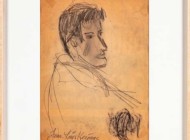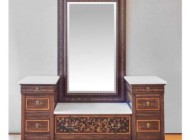Review and Photos by Rick Russack
MIDDLEBOROUGH, MASS. — There were certainly some surprises at White’s October 2 sale. One that even surprised the auctioneer was an uncut sheet of Panamanian currency. A good group of toys and a selection of coins also sold well over estimates. More than 50 lots of art pottery were sold, and White had a small selection of items relating to “General” Tom Thumb. The highlight of the day was a 3½-carat platinum and diamond engagement ring, which ended up at $14,375. There was a good crowd, with several phone lines in use, internet bidding was active, and there were numerous absentee bids.
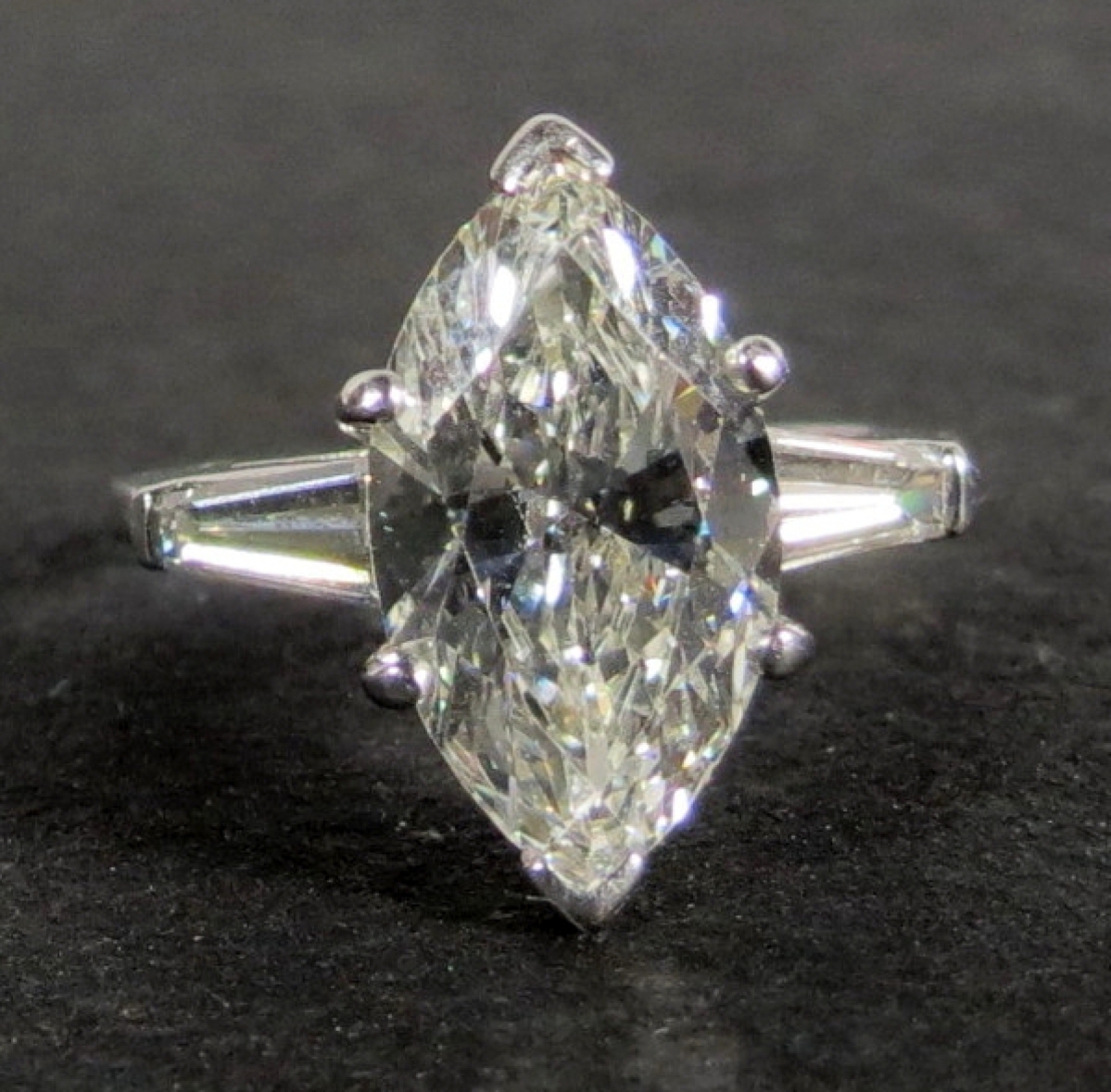
The top lot of the day was a platinum mounted diamond ring with a 3½-carat marquise cut diamond, flanked by tapered baguette diamonds. Several phone lines competed with the internet until the final price of $14,375 was reached.
Wendell and Susan Chamberlain, Kingston, Mass., started collecting art pottery in the 1980s and this sale offered the first part of their collection. Hampshire pottery was one of the couple’s favorites, along with Rookwood, Weller, Saturday Evening Girls, and there were some pieces by other makers. Wendell Chamberlain is in the real estate business, and he and his wife were regular customers of White’s and other southeast Massachusetts auctions. This sale included several pieces of their artist-signed Rookwood, and these pieces did well.
Bringing the highest price of the group at $1,208 was a floral vellum vase signed by Lenore Asbury, who worked for Rookwood about 1894–1931. Not far behind was a large 20-inch, circa 1892, standard glaze poppy vase with three handles. It was marked “S 1068 W,” indicating that it may have been an experimental piece, made in 1892, the first year that the then-new Mount Adams kiln was in use. It was well decorated with colorful poppies and apparently not signed. It realized $1,150. Leading the Weller pieces was a Fru Russet glazed vase about 6 inches tall. It was signed “Weller Rhead” and it finished at $892. Rhead only worked with Weller in 1903 and 1904, later becoming the first art director at the Roseville Pottery Co. There were some bargains to be had in this category. For example, an attractive Scheier bowl, in excellent condition, with a turquoise drip glaze over brown/purple brought only $230.
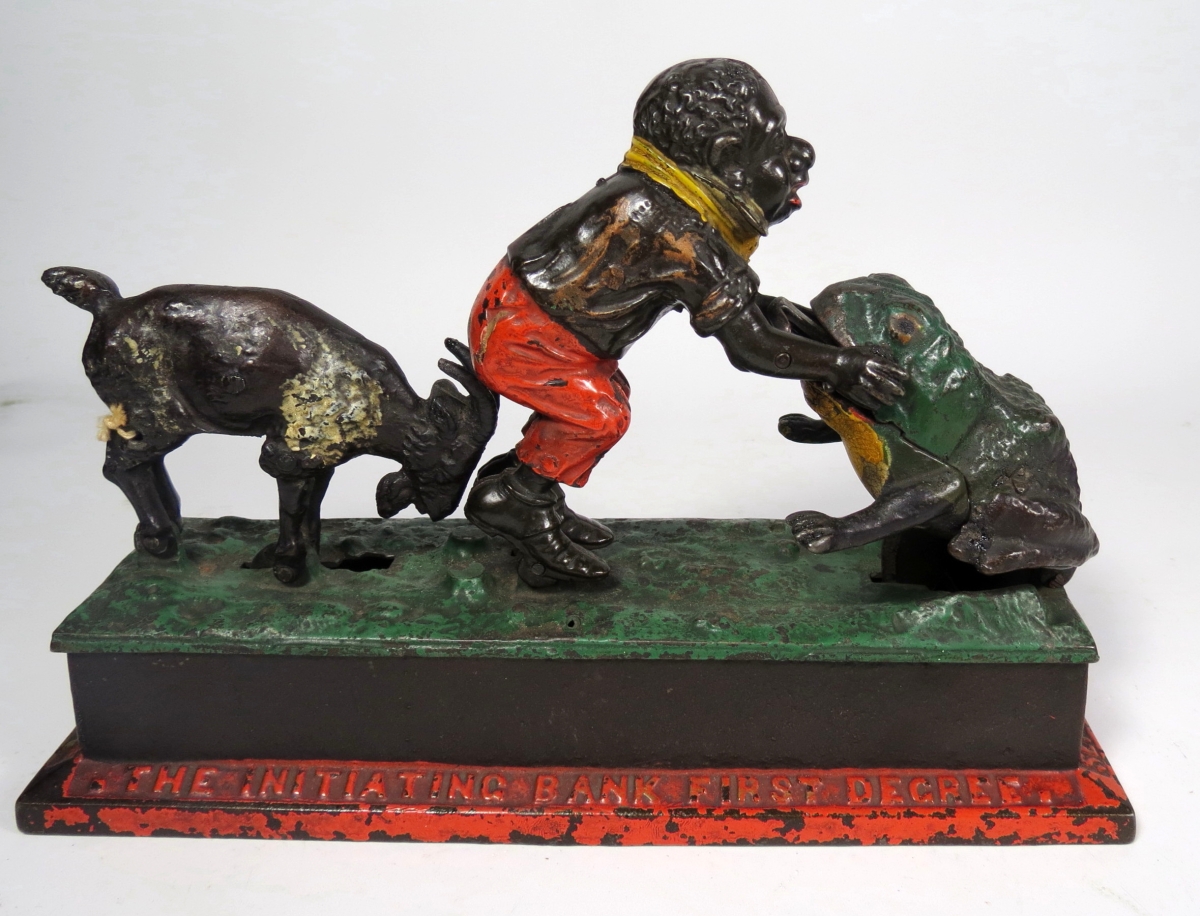
The second highest priced lot of the day was a scarce mechanical bank, part of the small collection of quality cast iron toys. Made by the Mechanical Novelty Co., circa 1880, “The Initiating Bank, First Degree,” in good condition, achieved $11,500.
A small selection of toys did very well, led by a rare mechanical bank. Made by the Mechanical Novelty Works of New Britain, Conn., circa 1880, the Initiating Bank, First Degree achieved $11,500, well over its estimate. The bank was patented by George W. Eddy, one of the owners of the company. The name of the bank probably refers to either the Odd Fellows or the Masons. It is a scarce bank and this one was in good condition. An uncommon cast iron still bank, the battleship Oregon, made by the J.E. Stevens, Co., circa 1902, also exceeded its estimate, reaching $3,220. The bank was painted white, as the Oregon was part of the “Great White Fleet,” which circumnavigated the globe between 1907 and 1909. From the same collection came one of the most interesting toys, or maybe a doll, depending on your point of view. It certainly has one of the longest names: Autoperipatikos Walking Doll. It was a small doll, with a papier mache head and a clockwork mechanism under its skirt that allows the doll to walk. It was patented in 1862, and this example was in very good condition, having won a blue ribbon at a doll collector’s meeting in 1984. It went to an absentee bidder for $1,093.
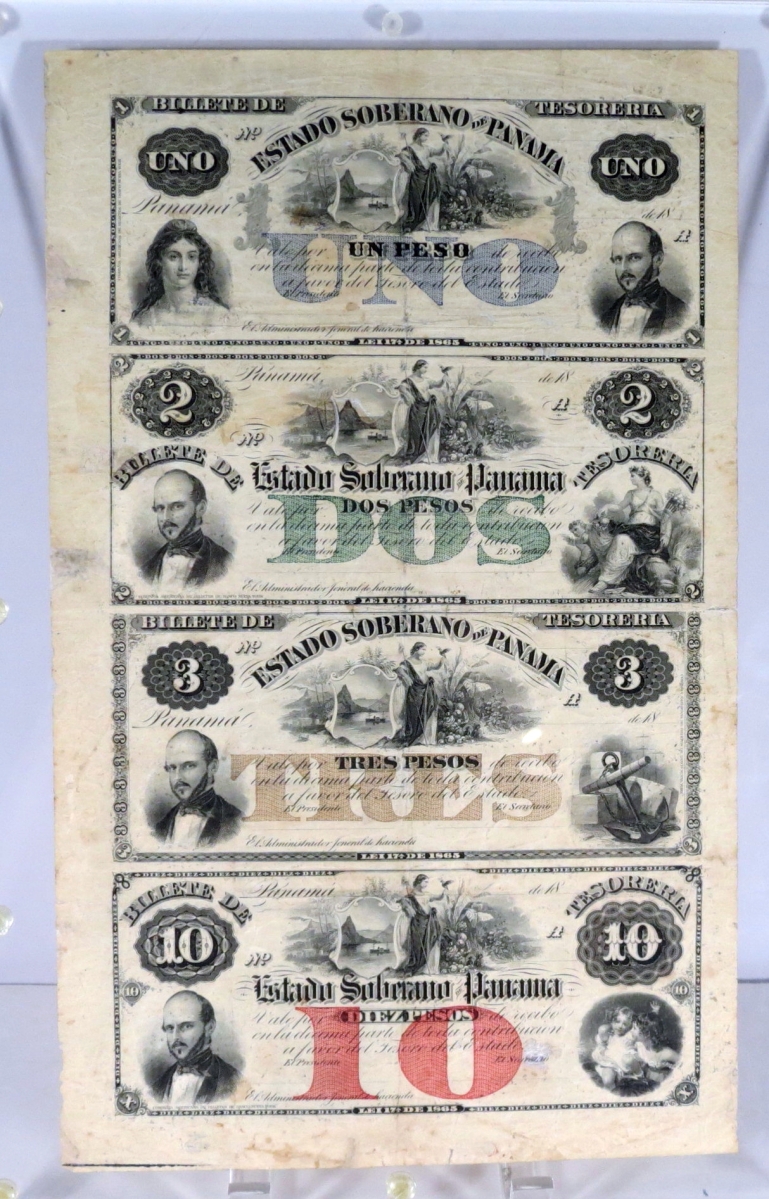
Even the auctioneer was surprised when this uncut sheet of Panama district, Spanish Colombia, bank notes opened at $8,000 against an estimate of $1,200. One of only a few such examples, it sold for $10,063.
White’s does not grade coins and currency, leaving that to the buyers, but that policy does not have a negative impact on prices. Most of the coins and currency lots sold well over the estimates, with a rare, uncut sheet of Panama district, Spanish Colombia bank notes surprising all, including the auctioneer, when it opened at $8,000 against the estimate of $1,200. It finished at $10,063, with the buyer saying that it was only the second such sheet known.
The sheet of four notes was dated 1865, while Panama was part of Colombia. It did not become an independent country until 1903. A lot of eight Morgan dollars, dating from 1877 to 1921, from various mints, earned $1,955, more than three times over estimate. Also far exceeding estimate was a binder lot of US coins, which included well over 150 coins. It was estimated at $700 but went out at $3,910.
Charles Stratton (1838–1883), better known as “General” Tom Thumb, became world famous as an entertainer under the direction of P.T. Barnum. He married Lavinia Warren, who lived in Middleborough, and they made their home there, in a house specially designed for their diminutive size. Barnum and the “General” had a long and mutually profitable arrangement, with Stratton becoming a wealthy man. He was one of the leading celebrities of his day, having twice performed for Queen Victoria. When the couple married in 1863, Barnum’s promotion made the event front-page news and the ceremony was attended by more than 2,000 people.
Many items were produced in miniature for the couple. White’s sale included a miniature piano, believed to have been made by the Chickering Co, and a pair of specially made, inscribed, miniature bowling balls. The piano, which was a wedding present, realized $2,990, and went to an internet bidder from France. The bowling balls brought $1,208, and a group of printed materials and photographs seemed inexpensive, selling for only $173. The couple also owned a specially designed yacht and furniture made for them by John Henry Belter. Their home, listed on the National Register of Historic Places, is presently for sale. The world’s largest collection of Tom Thumb memorabilia, perhaps not surprisingly, is in the Middleborough Historical Museum.

Getting the sale off to a good start, the third item of the day was a Louis Vuitton hat box with a woven basket interior. It brought $5,980.
There were numerous interesting items included in the sale. The third item of the day was a Louis Vuitton hat box with a basket-weave interior that realized $5,980, and a little later, an Edison stock market ticker tape machine, dating to the late Nineteenth Century, fetched $5,060. A colorful, coin-operated counter top horse race game earned $432. An Ansco 8-by-10-foot studio camera, on an adjustable wooden stand, seemed reasonable, bringing $489. A 12-by-16-foot antique Oushak carpet, circa 1900, reached $5,520. It, and other rugs, came from the home of Nicholas Salgo, former ambassador to Hungary and onetime owner of the infamous Watergate complex in Washington, D.C. A round Nantucket basket, signed Lottie Baker, attained $316, while an oval fingered box with a natural finish, made by Charles Hersey, Hingham, Mass., brought only $115. From the same collection as the art pottery, a Tiffany Studios bronze and green slag glass double inkwell made $2,300. Two letters from a Confederate soldier at the notorious Fort Pillow in Tennessee, dated 1861, with interesting military content, sold for $345. The fort was the site a few years later of the “Fort Pillow massacre,” in which hundreds of surrendering Union troops, mostly black, were killed by Confederate troops under the orders of General Nathan Bedford Forrest, refusing to treat the black soldiers as prisoners of war.
White’s is a family affair. John White, and his wife and partner, Kathryn Black, are assisted by White’s mother and sister. After the sale, the Whites said, “We had a good crowd. We were particularly pleased with the results achieved by the jewelry and coins. Those buyers knew what they were looking at and knew what they wanted. We had more than 2,000 bidders registered online and several things went to international bidders. The Louis Vuitton hat box will go to London, Tom Thumb’s piano will go to France, and the Korean screen may go to Korea.” This was the second sale in the new gallery, which has been designed to make operations as simple as possible, with custom-designed loading ramps, wall systems that make it easy to display a variety of offerings, and a large shipping area.
All prices reported include the buyer’s premium.
For additional information, www.whitesauctions.com or call 508-947-9281.
[slideshow_deploy id=’1000276384′]


